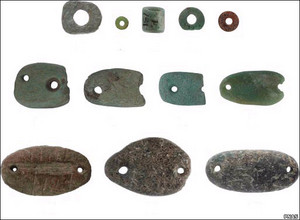
|
| ©PNAS |
| Beads and pendants from Gilgal II, an archaeological site in the Jordan Valley, and belonging to the Late Natufian culture. They are dated to between 11,600 and 10,500 years ago. |
The authors of the research suggest that early agriculturalists attached special importance to this colour.
Beads they recovered from dig sites in Israel had been made from a variety of green minerals and the farmers went to great efforts to obtain them.
Details appear in Proceedings of the National Academy of Sciences journal.
Daniella Bar-Yosef Mayer, from Israel's University of Haifa, and Naomi Porat, from the Geological Survey of Israel in Jerusalem, examined 221 beads from eight Neolithic (or late stone age) sites dating to between 11,600 years ago and 8,200 years ago.
None of the minerals the beads were made from came from the immediate vicinity of the sites. Some were mined from as far afield as northern Syria, Cyprus and Saudi Arabia.
White, black, brown, yellow and red beads were being made tens of thousands of years before the advent of agriculture.
But the researchers point out that green beads are first found in significant numbers during the agricultural revolution which gained pace from about 10,000 years ago in the Near East.
"We propose that the green colour mimics the green of young leaf blades, which signify germination and embody the wish for successful crops and for success in fertility," the authors write in PNAS.
They suggest that the onset of agriculture brought on demographic changes such as higher birth rates, but also higher child mortality.
These early farmers may have developed new cultural devices for dealing with these changes.
Green beads were probably used as amulets to ward off evil and as charms for maintaining the fertility of both people and crops, say the researchers.



"Beads they recovered from dig sites in Israel had been made from a variety of green minerals and the farmers went to great efforts to obtain them."
Suppose, just suppose, these folks were not the gibbering, superstitious lot we so often seem to assume they were (so different from us civilized folks today). What if a string of these beads were the Fendi bag or Rolex watch of the the day? What if owning some simply meant you were successful enough to trade for them and you wanted to make sure your neighbors knew?
Sometimes a bead might be just a bead!